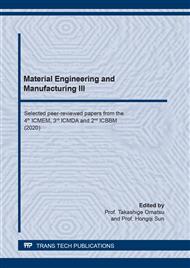[1]
C.S. Yuksel, S. Ankarali, and N.A. Yuksel: The Use of Neodymium Magnets in Healthcare and their Effects on Healt. North Clin Istanb, 5(3) (2018), pp.268-273.
Google Scholar
[2]
H. Jin, P. Afiuny, S. Dove, G. Furlan, M. Zakotnik, Y. Yih and J.W. Sutherland: Life Cycle Assessment of Neodymium-Iron-Boron Magnet-to-Magnet Recycling for Electric Vehicle Motors. Environ Sci Technol, 52(6) (2018), pp.3796-3802.
DOI: 10.1021/acs.est.7b05442
Google Scholar
[3]
J. Liu and C. Chinnasamy: Rare Earth Magnet Recycling, in Rare Earth Element workshop. EPA-Colorado, May 10, (2012).
Google Scholar
[4]
T.V. Hoogerstraete, B. Blanpain, T.V. Geren and K. Binnemans: Fom NdFeB Magnets Towards the Rare-Earth Oxides: a Recycling Process Consuming only Oxalic Acid. RSC Advances, 4 (2014), pp.64099-64111.
DOI: 10.1039/c4ra13787f
Google Scholar
[5]
J.P. Rabatho, W, Tonggamp, Y. Takasaki, K. Haga and A. Shibayama: Recovery of Nd and Dy from Rare Earth Magnetic Waste Sludge by Hydrometallurgical Process. Journal of Material Cycles and Waste Management, 15(2) (2012), pp.171-178.
DOI: 10.1007/s10163-012-0105-6
Google Scholar
[6]
M.A.R. Önal, C.R. Borra, M. Guo, B. Blanpain and T.V. Gerven: Recycling of NdFeB Magnets Using Sulfation, Selective Roasting, and Water Leaching. Journal of Sustainable Metallurgy, 1(3) (2015), pp.199-215.
DOI: 10.1007/s40831-015-0021-9
Google Scholar
[7]
C.-H. Lee, Y.-J Chen, C.-H Liao, S.R. Popuri, S.-L Tsai and C.-E Hung: Selective Leaching Process for Neodymium Recovery from Scrap Nd-Fe-B Magnet. Metallurgical and Materials Transactions A, 44(13) (2013), pp.5825-5833.
DOI: 10.1007/s11661-013-1924-3
Google Scholar
[8]
E.G Polyakov, and A.S. Sibilev: Recycling Rare-Earth-Metal Waste using Hydrometallurgical Methods. Theoretical Foundations of Chemical Engineering, 50(4) (2016), pp.607-612.
DOI: 10.1134/s0040579516040266
Google Scholar
[9]
Neodymium sulfate. Available from: https://www.chemicalbook.com/ChemicalProductProperty_EN_CB1705313.htm.
Google Scholar
[10]
Iron(III) oxide. Available from: https://en.wikipedia.org/wiki/Iron(III)_oxide.
Google Scholar
[11]
P.K. Gallagher, D.W. Johnson and F. Schrey: Thermal Decomposition of Iron(II) Sulfates. Journal of the American Ceramic Society, 53(12) (1970), p.666–670.
DOI: 10.1111/j.1151-2916.1970.tb12038.x
Google Scholar
[12]
M.S.R. Swamy and T.P. Prasad: Kinetics of the Thermal Decomposition of Iron(II) Sulphate Heptahydrate in Air. Thermochimica Acta, 62(2-3) (1983), pp.229-236.
DOI: 10.1016/0040-6031(83)85042-4
Google Scholar
[13]
N. Kanari, N.-E Menad, E. Ostrosi, S. Shallari, F. Diot, E, Allian and J. Yvon: Thermal Behavior of Hydrated Iron Sulfate in Various Atmospheres. Metals, 8(12) (2018), pp.193-201.
DOI: 10.3390/met8121084
Google Scholar
[14]
R.V. Siriwardane, J.A. Poston Jr., E.P. Fisher, M.-S. Shen and A.L. Miltz: Decomposition of the Sulfates of Copper, Iron II , Iron III , Nickel, and Zinc: XPS, SEM, DRIFTS, XRD, and TGA Study. Applied Surface Science, 152(3-4) (1999), pp.219-23.
DOI: 10.1016/s0169-4332(99)00319-0
Google Scholar
[15]
M.W. Nathans and W.W. Wendlandt: The Thermal Decomposition of the Rare-Earth Sulphates: Thermogravimetric and Differential Thermal Analysis Studies up to 1400°C. Journal of Inorganic and Nuclear Chemistry, 24(7) (1962), pp.869-879.
DOI: 10.1016/0022-1902(62)80108-0
Google Scholar


